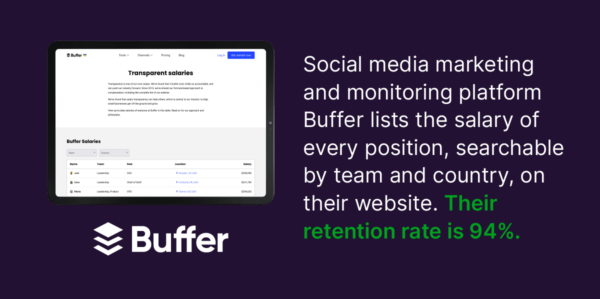The labor market at the start of 2023 continues to be a unique — and dare I say weird — one. Despite fears of a potential recession and a rash of high-profile layoffs in the tech industry, the overall job market remains tight. Additionally, recent indicators signal that the Great Resignation isn’t slowing down yet: In the U.S., 46% of professionals are looking or plan to look for a new role in the first half of 2023, up from 41% six months ago.
In response to this complex swirl of labor market factors, many HR teams have shifted their focus to retention while implementing hiring slowdowns or freezes. All of this means that you’ll probably be relying more on career development, training, transfers, and promotions to fill open roles.
While there are many benefits to retaining and promoting employees, there’s also a risk: women and BIPOC employees are less likely to get raises over time, leading to larger and larger pay equity gaps. Even if you’re analyzing pay equity and correcting gaps when you find them, you’re also potentially reintroducing disparities as your employees move up in your organization.
So why does pay equity and opportunity for advancement matter so much if you want to retain talent — and how do you ensure ongoing equitable pay as employees move around internally? Read on to learn.
4 keys to talent resilience
1. Overall pay
During times of economic stress, pay is in sharp focus. In the face of rising inflation cutting into paychecks, pay-related worries such as meeting monthly expenses, having the ability to retire, and personal debt are rising to the top of what keeps employees up at night. And according to Zippia, not being paid enough is the top reason workers are leaving their jobs, with 37% citing that “pay was too low” as the major reason they quit. Rewarding employees appropriately matters more than ever.
“The top attrition driver is compensation. Employees want to be compensated fairly and will change jobs to get that pay.”
Gartner | Gartner’s Top Strategic Predictions for 2023 and Beyond – Seizing Uncertainty, November 11, 2022
2. Pay equity
It’s not just the level of pay that matters to workers, but the perceived fairness of pay. HR analyst Josh Bersin states that pay programs “must focus on equity above all” because employees who don’t understand why they’re paid what they’re paid are likely to be unhappy. According to a Gartner press release titled ‘Gartner HR research finds only 32% of employees believe their pay is fair’ dated November 28, 2022, “Less than one-third of employees feel they are paid fairly, while just 34% of employees believe their pay is equitable.”
Getting pay equity right can have a positive impact on retention. One of the statistical planning assumptions in the report ‘Gartner’s Top Strategic Predictions for 2023 and Beyond — Seizing Uncertainty’ published November 11, 2022 is that, “By 2025, organizations that remediate documented gender pay gaps will decrease women’s attrition by 30%, reducing pressure on talent shortages.” Additionally, the perception of pay equity has a demonstrable impact on employees’ intent to stay and engagement. A Gartner press release stated that “The Gartner survey of 3,523 employees in 2Q22 also found that employees who perceive their pay as unequitable have a 15% lower intent to stay with their employer and are 13% less engaged at work than employees who perceive their pay as equitable.”
3. Pay transparency

Employees are also less likely to leave when they know more about what jobs at their companies are paid. A survey on pay transparency found that 79% of all survey respondents want some form of pay transparency and 32% want total transparency, in which all employee salaries are publicized. The survey also found that 68% of employees would switch employers for greater pay transparency, even if compensation was the same.
And it’s not just about the “what.” Employees want “pay explainability,” that is, understanding why they are paid what they are paid. A Gartner press release stated that “When organizations educate employees about how pay is determined, employee trust in the organization increases by 10% and pay equity perceptions increase by 11%.”
With the rise of pay transparency, employees are also starting to know much more about what they should be paid — including for promotions — because they can find out what their colleagues are making at their company and what employees in similar roles are making at other companies.
4. Opportunities for growth and advancement
One of the top ways to give employees a reason to stay at your company is providing opportunities for advancement. The 2022 Work Institute Retention Report found that career-related reasons for leaving a company (e.g., lack of opportunities for growth, promotion, or learning) was a top theme in turnover. According to Zippia, 33% of workers said lack of advancement opportunities was the major reason they left their jobs. Companies need to also ensure that employees have equitable access to career opportunities, or else they risk widening the pay gap for women and BIPOC employees.
How to create a framework for talent resilience
To keep employees in today’s economic environment, organizations must do it all: pay employees competitively, fairly, and transparently, as well as providing clear avenues for growth. But maintaining pay equity amidst internal movement can be a challenge since you’re dealing with an accumulated history of compensation decisions that have been made over time within your organization.
Accordingly, when you go to promote or transfer someone, you need the ability to see:
- How the employee’s current pay compares to the pay for the position they will be promoted or transferred into
- How their pay then compares to employees in the same and similar roles when controlling for things like experience, recent performance, location, and other elements of your pay programs
- How their pay compares to the market and/or salary range for their new role
You may uncover that there’s a disconnect between what you typically budget for a promotion increase (e.g., “a promotion is 10% of base salary”) vs. how real-world compensation circumstances impact the person you’re looking to promote. That’s why it’s important ensure that the salary for the promotion will be:
- A meaningful difference in pay from the current salary
- Consistent with how others in the same job are paid for the job
- Aligned with the career progression for the job
- Congruent with your internal equity (i.e. not unintentionally creating any pay inequities)
- Competitive with the market and/or appropriate for how you manage pay in your ranges
Leading companies are achieving this through three key steps:
1. Conducting more frequent pay equity analyses to keep track of internal equity as pay changes. By analyzing pay equity with PayEQ® as compensation changes, organizations can begin with a more accurate, ongoing picture of pay equity at their organizations, creating a better environment within which to make new pay decisions without creating new inequities.
2. Modeling promotions and transfers to ensure alignment with external market data and/or the salary structure, as well as with internal equity (by leveraging their pay equity analyses). Pay Finder™ provides organizations with a comprehensive view of current pay for the same and similar roles, market data and/or salary structures, and an equitable pay range calculated from their pay equity analyses, so compensation teams can make pay changes with confidence.
3. Analyzing opportunities for career development to ensure employees have equitable access. By evaluating job levels and job families to better understand gaps in talent using OppEQ ™, companies can unpack opportunities to create greater bench strength and develop career paths to fill positions internally, helping build better engagement across their teams.
Want to retain top talent? Show them they have an equitable future with you
Internal mobility will become increasingly important this year as hiring slows. Not only will the ability to fill gaps and open roles depend more heavily on internal promotions and transfers, but your existing employees want to know they have a path for growth opportunities or else they’ll be on the move themselves. They’re also keen to know that their pay is fair.
By using data to ensure that every pay change maintains pay equity, you’ll be able to communicate, explain, and prove that pay is equitable. Want to learn how PayEQ Pay Finder provides insights and recommendations to guide equitable compensation decisions at every step of the employee lifecycle, from new hire to promotion and transfer? Click the link below.
The information provided herein does not, and is not intended to, constitute legal advice. All information, content, and materials are provided for general informational purposes only. The links to third-party or government websites are offered for the convenience of the reader; Syndio is not responsible for the contents on linked pages.



